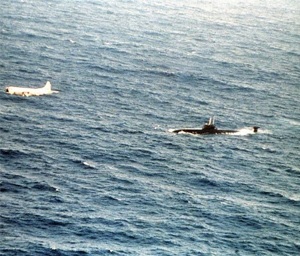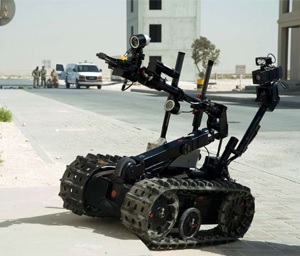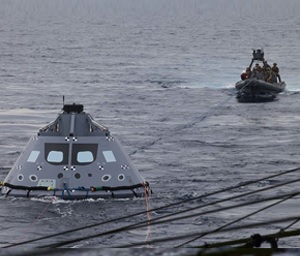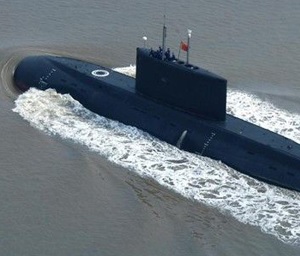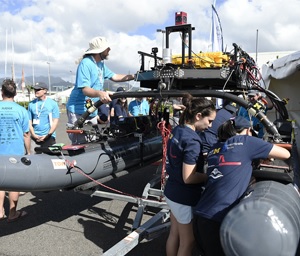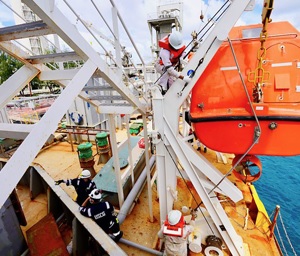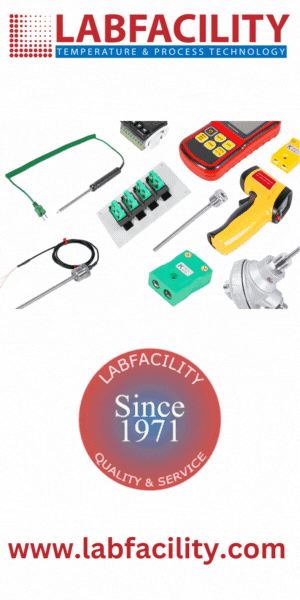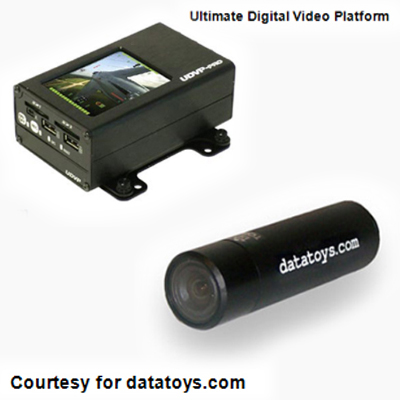Deep Sea Protectors: The Strategic Value of ROVs in Naval Defence 20 June 2024
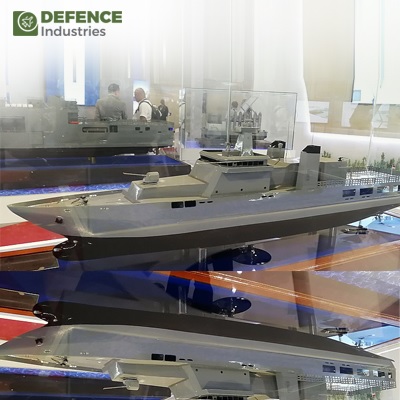
The vast expanse of the world's oceans has always been a theater of both opportunity and threat. In the domain of naval defence, Remote Operated Vehicles (ROVs) have emerged as indispensable assets. These sophisticated pieces of technology are enhancing anti-submarine warfare, bolstering military robotics, advancing oceanographic research, and strengthening maritime security. Their strategic value extends across various facets of naval operations, from deep sea exploration and supporting naval special forces to aiding the naval undersea warfare center. They play crucial roles in international ship port security and provide invaluable assistance to ship security officers. By leveraging remote sensing and autonomous systems, ROVs support seabee combat warfare and the naval special warfare command in maintaining an edge in anti-submarine warfare. Their contributions to military robotics, submarine detection, and maritime security underscore their importance in modern defence strategies, ensuring comprehensive oceanographic research and robust maritime security operations.
Anti-Submarine Warfare
In anti-submarine warfare, the ability to detect, track, and neutralize enemy submarines is crucial. ROVs, equipped with advanced sonar and sensor systems, play a pivotal role in these anti-submarine warfare operations. They can be deployed to depths that are challenging for manned vessels, providing real-time data and visuals of underwater threats. These vehicles, part of the broader military robotics arsenal, can operate silently, minimizing the risk of detection by enemy forces. By enhancing the capabilities of naval special forces and the Naval Undersea Warfare Center, ROVs contribute significantly to maintaining the strategic upper hand in underwater engagements. Their role in anti-submarine warfare is further supported by their ability to integrate remote sensing and autonomous systems, which are essential for deep sea exploration. These advancements in military robotics not only bolster maritime security but also assist the ship security officer and contribute to international ship port security. Furthermore, ROVs play a crucial role in seabee combat warfare and support the naval special warfare command in their missions. Their contributions to oceanographic research and submarine detection make them indispensable in modern anti-submarine warfare strategies.
Military Robotics in Naval Defence
The integration of military robotics into naval defence has revolutionized how operations are conducted. ROVs are a prime example of this technological advancement in military robotics. These unmanned systems can perform a variety of tasks, from anti-submarine warfare and surveillance to reconnaissance and mine detection. The Naval Special Warfare Command relies on these versatile robots for missions that are too dangerous or impractical for human divers. The ability to remotely operate these vehicles, part of the broader field of military robotics, reduces the risk to personnel while enhancing operational efficiency. These robots support naval special forces and the naval undersea warfare center in their critical operations. Additionally, ROVs play a vital role in oceanographic research and deep sea exploration, using remote sensing and autonomous systems to gather crucial data. They contribute significantly to maritime security, assisting the ship security officer and enhancing international ship port security. Their capabilities extend to seabee combat warfare, where they support engineering and construction tasks underwater. These advancements in military robotics ensure that submarine threats are effectively managed, solidifying their importance in modern naval defence strategies.
Oceanographic Research and Maritime Security
ROVs are also invaluable in oceanographic research, which directly contributes to maritime security. Understanding oceanic conditions and underwater geography is essential for strategic planning and mission execution in anti-submarine warfare. ROVs equipped with remote sensing technology gather critical data on ocean currents, temperatures, and seafloor topography. This information aids in navigation, the planning of naval operations, and the identification of potential underwater threats. Ship security officers and the international ship port security framework benefit from the enhanced surveillance capabilities provided by ROVs. These vehicles can inspect the hulls of ships, underwater structures, and port facilities for any signs of tampering or sabotage. Their ability to operate in challenging conditions ensures that security measures are upheld even in the most demanding environments.
ROVs, as part of military robotics, are essential for deep sea exploration and support naval special forces and the naval undersea warfare center. These unmanned systems enhance the capabilities of the naval special warfare command by providing real-time data and visuals for anti-submarine warfare and maritime security operations. Their use of autonomous systems and advanced remote sensing technology ensures comprehensive coverage and monitoring. In addition to their surveillance roles, ROVs are instrumental in seabee combat warfare, supporting construction and maintenance tasks underwater. The integration of military robotics into oceanographic research and maritime security strategies highlights their critical importance in modern naval operations, especially in detecting and neutralizing submarine threats.
Deep Sea Exploration and Naval Operations
The role of ROVs in deep sea exploration cannot be overstated. These vehicles are crucial for both oceanographic research and maritime security, providing valuable data and capabilities. In anti-submarine warfare, ROVs offer unmatched precision and depth in remote sensing, enhancing the effectiveness of military robotics. For naval special forces, this capability means that missions can be planned with a detailed understanding of the underwater terrain, vital for the naval undersea warfare center and seabee combat warfare operations.
Additionally, ROVs can be used to recover objects from the seafloor, such as sunken vessels or equipment, providing valuable intelligence and materials for analysis. These autonomous systems support the naval special warfare command by offering advanced tools for submarine detection and recovery, which is essential for maintaining maritime security. The enhanced capabilities of military robotics also aid ship security officers and bolster international ship port security efforts.
Incorporating ROVs into deep sea exploration extends their use beyond scientific research to strategic military applications, reinforcing the importance of anti-submarine warfare and military robotics in modern naval operations. Their ability to gather and analyze data through remote sensing ensures that naval missions are informed and precise, further solidifying their role in supporting naval special forces and ensuring comprehensive maritime security.
Autonomous Systems and Submarine Warfare
The development of autonomous systems has further enhanced the capabilities of ROVs in naval defence, particularly in anti-submarine warfare. These systems can operate independently, following pre-programmed instructions or adapting to new information in real-time. In the context of submarine warfare, autonomous ROVs can be deployed to patrol specific areas, monitor submarine activity, and even engage enemy vessels if necessary. This level of autonomy, a key feature of military robotics, reduces the need for constant human oversight, allowing for more efficient and flexible operations.
Autonomous systems in ROVs support naval special forces and the naval undersea warfare center by providing continuous remote sensing capabilities, essential for deep sea exploration and oceanographic research. They enhance maritime security by enabling ship security officers to monitor underwater threats and support international ship port security measures. Additionally, these systems play a critical role in seabee combat warfare, assisting in underwater construction and demolition tasks. The integration of autonomous systems into military robotics ensures that the naval special warfare command can conduct operations with greater precision and effectiveness.
The versatility and independence of these autonomous systems make them indispensable in modern naval defence, enhancing the effectiveness of anti-submarine warfare and maritime security operations. By leveraging advanced remote sensing technology, they provide invaluable support to naval special forces and ship security officers, ensuring that all aspects of submarine warfare and international ship port security are thoroughly managed and optimized.
Support to Naval Special Forces
ROVs provide critical support to naval special forces by performing reconnaissance and surveillance missions, essential for anti-submarine warfare and maritime security. These vehicles, a key component of military robotics, can be deployed ahead of a team to gather intelligence on enemy positions and fortifications. This real-time data, gathered through remote sensing and autonomous systems, allows naval special forces to plan their operations with greater precision and confidence.
Additionally, ROVs can be used in deep sea exploration to deploy sensors or communication equipment in inaccessible or hazardous areas, extending the reach and effectiveness of special operations teams. Their capabilities are crucial for the naval undersea warfare center and seabee combat warfare, providing the necessary support for complex underwater missions. ROVs enhance international ship port security by assisting the ship security officer in monitoring and securing port facilities.
The integration of military robotics in oceanographic research also benefits naval special forces by providing a better understanding of underwater environments. The naval special warfare command relies on these technologies to execute missions with minimal risk and maximum efficiency. ROVs are indispensable in modern naval operations, enhancing anti-submarine warfare strategies and ensuring comprehensive maritime security.
Naval Undersea Warfare Center and Seabee Combat Warfare
The Naval Undersea Warfare Center and Seabee Combat Warfare units rely on the capabilities of ROVs to enhance their operational effectiveness in anti-submarine warfare and maritime security. These military robotics are instrumental in undersea warfare tasks like mine countermeasures, underwater demolition, and infrastructure inspection. Equipped with advanced sensors and manipulator arms, ROVs can identify and neutralize underwater mines, ensuring safe passage for naval vessels and supporting international ship port security measures. In Seabee Combat Warfare, these autonomous systems assist in constructing and maintaining underwater structures, providing vital support to engineering operations and enhancing ship security officer duties.
Enhancing International Ship Port Security
The role of ROVs in international ship port security is multifaceted and crucial for maritime security. These military robotics can conduct underwater inspections of port facilities, ensuring the safety and security of shipping operations and supporting ship security officers. They are also deployed to monitor underwater areas for suspicious activity, providing an additional layer of security and contributing to international ship port security measures. By enhancing the capabilities of port security teams with autonomous systems and advanced remote sensing, ROVs play a vital role in the overall safety and efficiency of maritime operations, including anti-submarine warfare considerations.
Remote Sensing and Data Collection
Remote sensing is a key capability of ROVs that enhances their value in naval defence and maritime security. These military robotics are equipped with a variety of sensors, including sonar, cameras, and environmental sensors, which allow them to collect detailed data on underwater conditions. This information is critical for mission planning and execution in anti-submarine warfare and oceanographic research, as it provides a comprehensive understanding of the operational environment. The ability to collect and analyze data in real time ensures that naval forces can make informed decisions and respond quickly to emerging threats, benefiting ship security officers and international ship port security measures.
The Future of ROVs in Naval Defence
The future of ROVs in naval defence and maritime security is expected to be shaped by advancements in military robotics and autonomous systems. These innovations will lead to even more capable and versatile ROVs that can operate effectively in anti-submarine warfare, support oceanographic research, and enhance international ship port security measures. As technology continues to advance, ROVs will play a crucial role in deep sea exploration and naval special forces operations, supporting the naval undersea warfare center and naval special warfare command. The integration of artificial intelligence and machine learning will further enhance ROVs' capabilities, enabling them to perform more complex tasks autonomously and reducing the need for constant human intervention, benefiting ship security officers and ensuring comprehensive maritime security.
Conclusion:
In conclusion, ROVs are invaluable assets in the realm of naval defence and maritime security. Their contributions to anti-submarine warfare, military robotics, oceanographic research, and maritime security underscore their strategic importance. By enhancing the capabilities of naval special forces, the Naval Undersea Warfare Center, and Seabee Combat Warfare units, ROVs play a critical role in maintaining the security and operational effectiveness of naval forces. As technology continues to advance, the strategic value of ROVs in naval defence will only continue to grow, ensuring that they remain a cornerstone of modern naval operations.



